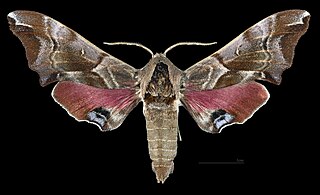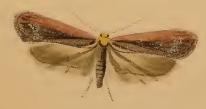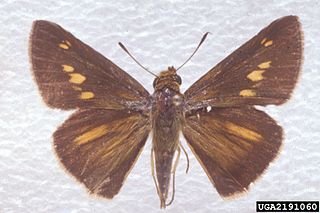
The luna moth, also called the American moon moth, is a Nearctic moth in the family Saturniidae, subfamily Saturniinae, a group commonly named the giant silk moths.

The Lasiocampidae are a family of moths also known as eggars, tent caterpillars, snout moths, or lappet moths. Over 2,000 species occur worldwide, and probably not all have been named or studied. It is the sole family in superfamily Lasiocampoidea.

The spiny oak slug is the larval form (caterpillar) of a moth in the family Limacodidae.

Perigonia lusca, the half-blind sphinx or coffee sphinx, is a moth of the family Sphingidae. It was first described by Johan Christian Fabricius in 1777.

Aellopos clavipes, also known as the clavipes sphinx, is a moth of the family Sphingidae.

The small lappet moth is a moth in the family Lasiocampidae. The species was first described by Carl Linnaeus in his 1758 10th edition of Systema Naturae. It is found throughout Europe and parts of Asia.

Phyllodesma is a Holarctic genus of moths in the family Lasiocampidae. The genus was first described by Jacob Hübner in 1820.

Amphipoea americana, the American ear moth, is a moth of the family Noctuidae. The species was first described by Adolph Speyer in 1875. It is found from coast to coast in the northern United States and southern Canada, it is also present in the Northwest Territories, south in the west to California, south in the east to Georgia

Colocasia propinquilinea, the closebanded yellowhorn, is a moth of the family Noctuidae. The species was first described by Augustus Radcliffe Grote in 1873. It is found in North America from Newfoundland and Labrador, west across the southern edge of the boreal forest to central Alberta, south to North Carolina, Missouri and Arkansas.

Ancylis comptana, the strawberry leaf-roller or Comptan's ancylis moth, is a moth of the family Tortricidae. It is found from the United Kingdom and Scandinavia to northern Spain and Turkey, Asia Minor, Kazakhstan, Uzbekistan, Russia, China, Mongolia, Korea and Japan. In North America, it is represented by ssp. fragariae.

Calpodes ethlius, the Brazilian skipper, larger canna leafroller or canna skipper, is a butterfly of the family Hesperiidae. It is found in the United States from southern Florida and southern Texas, south through the West Indies, Mexico, and Central America to Argentina. Strays and temporary colonies can be found north to southern Nevada, northern Texas, Illinois and Massachusetts.

Elachista subalbidella is a moth of the family Elachistidae found in Europe and North America.

Stigmella tiliae is a moth of the family Nepticulidae. It is found in all of Europe, except the Balkan Peninsula and the Mediterranean Islands.

Smerinthus kindermannii, the southern eyed hawkmoth, is a species of moth of the family Sphingidae. It is found throughout the central Palaearctic Region, from Turkey, Cyprus and Lebanon, east through Iraq, Iran, Afghanistan and northern Pakistan to Kashmir. From there, north and north-east through Turkmenistan, Uzbekistan, Tajikistan, Kyrgyzstan and Kazakhstan, to north-western China. It has also been reported from Israel and Kuwait.
G. californica may refer to:

Blunt’s flat-body or purple carrot-seed moth is a moth of the family Depressariidae. It is found in most of Europe. It is also found in the Near East, North Africa, the eastern part of the Palearctic realm and since 2009 in North America. In the former USSR, it is distributed in the entire European part except for the Far North. It is also found in the northern Caucasus and Transcaucasia, in Kazakhstan, Central Asia, the south of Siberia, and the Russian Far East. It is an introduced species in North America, where it has been reported from Québec and Ontario.

Euphyes dion, the Dion skipper or Alabama skipper, is a species of butterfly of the family Hesperiidae. It is found in scattered populations along the Atlantic coast of North America, from western Massachusetts and south-eastern New York south to north-eastern Florida, west to north-eastern Texas, and north to south-eastern North Dakota, northern Wisconsin, southern Ontario and southern Quebec. It is listed as a species of special concern in the US state of Connecticut.

Callophrys augustinus, the brown elfin, is butterfly of the family Lycaenidae. It is found from Newfoundland north and west through the northern United States and the prairie provinces to Alaska. To the south it ranges in Appalachian Mountains to northern Georgia and northern Alabama, further south through the western mountains to northern Baja California in Mexico. Subspecies iroides is known as the western elfin.

Virbia laeta, the joyful holomelina, is a moth in the family Erebidae. It was described by Félix Édouard Guérin-Méneville in 1844. It is found in North America from New Brunswick south to Florida and west to Minnesota and south to Texas. The habitat consists of pine woodlands.

Pandemis lamprosana, the woodgrain leafroller moth, is a species of moth of the family Tortricidae. It is found in North America, where it has been recorded from the north-eastern United States, Quebec and Ontario.



















